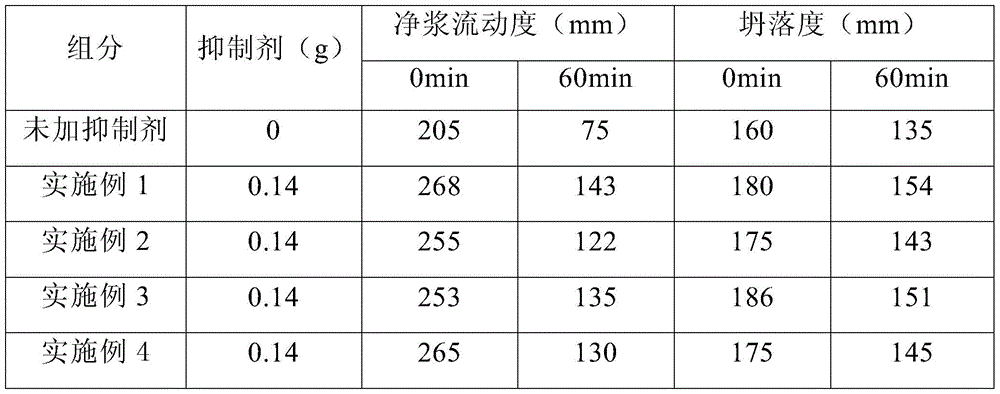A kind of preparation method of amphoteric polycarboxylate clay inhibitor
The technology of amphoteric polycarboxylate and clay inhibitor is applied in the field of preparation of amphoteric polycarboxylate clay inhibitor, which can solve the problems of reducing strength and durability, affecting the later strength of concrete, increasing concrete shrinkage, etc. The ability to resist clay, the shielding and dispersing effect is good, and the effect is beneficial to industrial production
- Summary
- Abstract
- Description
- Claims
- Application Information
AI Technical Summary
Problems solved by technology
Method used
Image
Examples
Embodiment 1
[0018] In a reactor with a reflux and stirring device, dissolve 2.5 g of unsaturated sulfonate monomer and 1.5 g of methacryloyloxyethyl dimethylamine in 60 g of deionized water, stir to dissolve, and heat up to 60 At ℃, start to add 2.0g ammonium persulfate dissolved in 12g deionized water and 32.5g unsaturated carboxylic acid monomer by dropping at the same time, control the dropwise addition in 1.5 hours, keep the temperature for 4.0 hours, and then cool down to 40 After ℃, use 0.5g of dimethyl sulfate for quaternization for 1 hour, add sodium hydroxide to neutralize to pH = 5-6, and obtain a light yellow viscous transparent liquid, which is an amphoteric polycarboxylic acid Salt clay inhibitor.
Embodiment 2
[0020] In a three-port reactor with reflux and stirring devices, dissolve 3g of unsaturated sulfonate monomer and 1.5g of methacryloyloxyethyl dimethylamine in 65g of deionized water, stir to dissolve, and heat up to 85°C. At the same time, dissolve 2.0g potassium persulfate and 37.5g acrylic acid monomer with 12g deionized water by dropwise addition, control the dropwise addition in 2.0 hours, and keep it warm for 3.0 hours, then cool down to 45°C, use 0.5g sulfuric acid Dimethyl ester was subjected to quaternization reaction for 1 hour, and then neutralized with sodium hydroxide to pH=5-6 to obtain a light yellow viscous transparent liquid, which was an amphoteric polycarboxylate clay inhibitor.
Embodiment 3
[0022] In a three-port reactor with reflux and stirring devices, dissolve 5g of unsaturated sulfonate monomer and 2.5g of methacryloyloxyethyl dimethylamine in 70g of deionized water, stir to dissolve, and heat up to 80°C , start to add 2.0g of sodium persulfate initiator and 35g of methacrylic acid monomer dissolved in 12g of deionized water at the same time by dropwise addition, control the dropwise addition in 2.0 hours, and keep the reaction for 3.5 hours, and then cool down to 40°C, Use 1.0g of diethyl sulfate for quaternization for 1.5 hours, and then neutralize with sodium hydroxide to pH=5-6 to obtain a light yellow viscous transparent liquid, which is an amphoteric polycarboxylate clay inhibitor agent.
PUM
 Login to View More
Login to View More Abstract
Description
Claims
Application Information
 Login to View More
Login to View More - R&D
- Intellectual Property
- Life Sciences
- Materials
- Tech Scout
- Unparalleled Data Quality
- Higher Quality Content
- 60% Fewer Hallucinations
Browse by: Latest US Patents, China's latest patents, Technical Efficacy Thesaurus, Application Domain, Technology Topic, Popular Technical Reports.
© 2025 PatSnap. All rights reserved.Legal|Privacy policy|Modern Slavery Act Transparency Statement|Sitemap|About US| Contact US: help@patsnap.com

